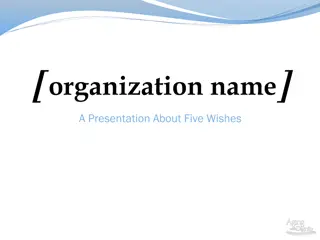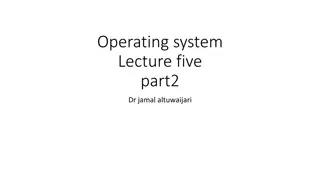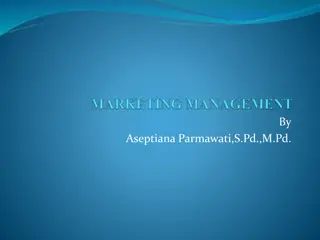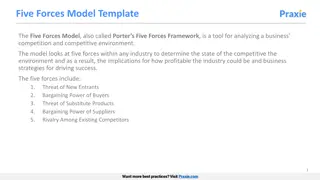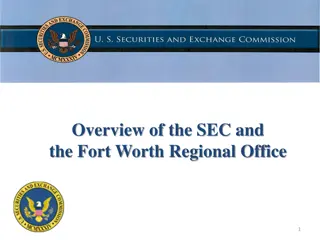LECTURE TWENTY FIVE
Friction welding is a solid-state welding process where coalescence is achieved through frictional heat and pressure. No melting occurs at the faying surfaces, and no filler metal or shielding gases are used. This process, introduced in the 1960s, is amenable to automated production methods and is widely used in various industries such as automotive, aircraft, and petroleum.
Download Presentation

Please find below an Image/Link to download the presentation.
The content on the website is provided AS IS for your information and personal use only. It may not be sold, licensed, or shared on other websites without obtaining consent from the author.If you encounter any issues during the download, it is possible that the publisher has removed the file from their server.
You are allowed to download the files provided on this website for personal or commercial use, subject to the condition that they are used lawfully. All files are the property of their respective owners.
The content on the website is provided AS IS for your information and personal use only. It may not be sold, licensed, or shared on other websites without obtaining consent from the author.
E N D
Presentation Transcript
LECTURE TWENTY FIVE Friction and ultrasonic welding
FRICTION WELDING Friction welding is a widely used commercial process, amenable to automated production methods. The process was developed in the (former) Soviet Union and introduced into the United States around 1960. Friction welding (FRW) is a solid state welding process in which coalescence is achieved by frictional heat combined with pressure. The friction is induced by mechanical rubbing between the two surfaces, usually by rotation of one part relative to the other, to raise the temperature at the joint interface to the hot working range for the metals involved. Then the parts are driven toward each other with sufficient force to form a metallurgical bond.
Figure 25.1 illustrate The sequence is portrayed in for welding two cylindrical parts, the typical application. The axial compression force upsets the parts, and a flash is produced by the material displaced. Any surface films that may have been on the contacting surfaces are expunged during the process. The flash must be subsequently trimmed (e.g., by turning) to provide a smooth surface in the weld region. When properly carried out, no melting occurs at the faying surfaces. No filler metal, flux, or shielding gases are normally used. Nearly all FRW operations use rotation to develop the frictional heat for welding. There are two principal drive systems, distinguishing two types of FRW: (1) continuous drive friction welding, (2) inertia friction welding.
. In continuous-drive friction welding, one part is driven at a constant rotational speed and forced into contact with the stationary part at a certain force level so that friction heat is generated at the interface. When the proper hot working temperature has been reached, braking is applied to stop the rotation abruptly, and simultaneously the pieces are forced together at forging pressures. In inertia friction welding, the rotating part is connected to a flywheel, which is brought up to a predetermined speed. Then The flywheel is disengaged from the drive motor, and the parts are forced together. The kinetic energy stored in the flywheel is dissipated in the form of friction heat to cause coalescence at the abutting surfaces. The total cycle for these operations is about 20 seconds.
Machines used for friction welding have the appearance of an engine lathe. They require a powered spindle to turn one part at high speed, and a means of applying an axial force between the rotating part and the nonrotating part. With its short cycle times, the process lends itself to mass production. It is applied in the welding of various shafts and tubular parts in industries such as automotive, aircraft, farm equipment, petroleum, and natural gas. The process yields a narrow heat-affected zone and can be used to join dissimilar metals. However, at least one of the parts must be rotational; flash must usually be removed, and upsetting reduces the part lengths (which must be taken into consideration in product design). The conventional friction welding operations discussed above utilize a rotary motion to develop the required friction between faying surfaces. A more recent version of the process is linear friction welding, in which a linear reciprocating motion is used to generate friction heat between the parts. This eliminates the requirement for at least one of the parts to be rotational (e.g., cylindrical, tubular).
ULTRASONIC WELDING Ultrasonic welding (USW) is a solid-state welding process in which two components are held together under modest clamping force, and oscillatory shear stresses of ultrasonic frequency are applied to the interface to cause coalescence. The operation is illustrated in Figure 25.2 for lap welding, the typical application. The oscillatory motion between the two parts breaks down any surface films to allow intimate contact and strong metallurgical bonding between the surfaces. Although heating of the contacting surfaces occurs due to interfacial rubbing and plastic deformation, the resulting temperatures are well below the melting point. No filler metals, fluxes, or shielding gases are required in USW.
The oscillatory motion is transmitted to the upper workpart by means of a sonotrode, which is coupled to an ultrasonic transducer. This device converts electrical power into high-frequency vibratory motion. Typical frequencies used in US Ware 15 to 75 kHz, with amplitudes of 0.018 to 0.13 mm (0.0007 0.005 in). Clamping pressures are well below those used in cold welding and produce no significant plastic deformation between the surfaces. Welding times under these conditions are less than 1 sec. USW operations are generally limited to lap joints on soft materials such as aluminum and copper. Welding harder materials causes rapid wear of the sonotrode contacting the upper workpart. Workparts should be relatively small, and welding thicknesses less than 3 mm (1/8 in) is the typical case. Applications include wire terminations and splicing in electrical and electronics industries (eliminates the need for soldering), assembly of aluminum sheet- metal panels, welding of tubes to sheets in solar panels, and other tasks in small parts assembly.
ADVANTAGES ULTRASONIC WELDING PROCESS 1. The process is excellent for joining thin sheets to thicker sheets, 2. Permits dissimilar metal joints 3. Provides joints with good thermal and electrical conductivity 4. Joins metals without the heat of fusion 5. Provides efficient energy use 6. Typically requires no filler material, flux, or special atmosphere 7. Typically requires no special cleaning processes 8. Welds through most oxides
FACTORS WHICH AFFECT THE WELD QUALITY IN ULTRASONIC WELDING PROCESS Composition and geometry of weldment Hardness of the workpiece Cleanliness of the weldment Selection of welding conditions, such as power, clamping force, and weld time Capacity of the tooling to properly support and clamp the parts to prevent unwanted vibration





